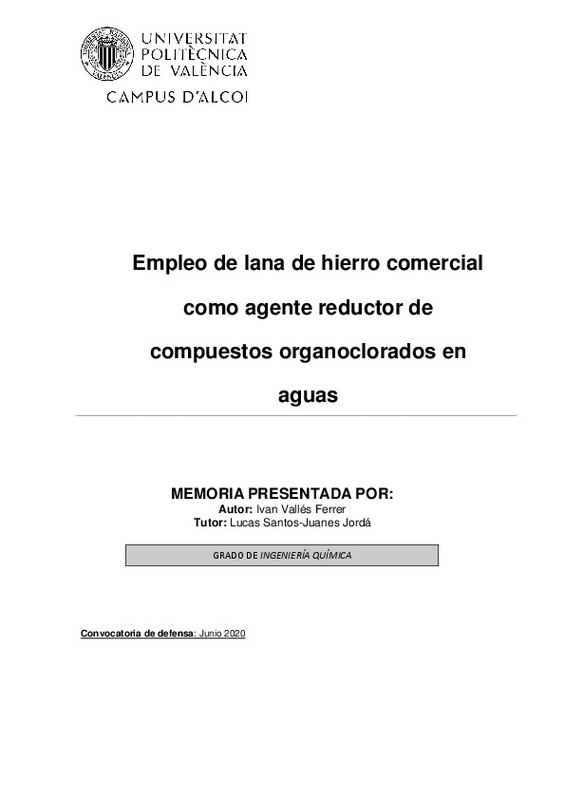JavaScript is disabled for your browser. Some features of this site may not work without it.
Buscar en RiuNet
Listar
Mi cuenta
Estadísticas
Ayuda RiuNet
Admin. UPV
Empleo de lana de hierro comercial como agente reductor de compuestos organoclorados en aguas
Mostrar el registro sencillo del ítem
Ficheros en el ítem
| dc.contributor.advisor | Santos-Juanes Jordá, Lucas
|
es_ES |
| dc.contributor.author | Vallés Ferrer, Ivan
|
es_ES |
| dc.date.accessioned | 2020-09-24T18:45:46Z | |
| dc.date.available | 2020-09-24T18:45:46Z | |
| dc.date.created | 2020-06-30 | |
| dc.date.issued | 2020-09-24 | es_ES |
| dc.identifier.uri | http://hdl.handle.net/10251/150699 | |
| dc.description.abstract | [ES] Los problemas de escasez de agua junto con la superpoblación humana provocan la falta de recursos y la necesidad de nuevos métodos de descontaminación. Uno de estos casos es la necesidad de la eliminación del 2,4-diclorofenol del medio. Tradicionalmente han sido usados procesos oxidativos para el control de este compuesto, aunque en este trabajo se explora una vía reductiva. De este modo se pretende de-clorar y reducir considerablemente la toxicidad de las moléculas al formar fenol. Para ello se ha empleado hierro como agente reductor. Se han probado diferentes formatos comerciales de hierro a diferentes caudales de agua contaminada, se ha visto el efecto de las sales presentes en agua de red sobre el proceso reductivo y se ha estudiado el mecanismo de degradación. Mediante el escalado a nivel industrial con los mejores resultados y tras el estudio de costes se ha podido constatar que la cantidad y precio del hierro son los que determinan la inviabilidad económica del proceso. Solamente si se pudiera hacer uso de residuos de la industria metalúrgica o del mecanizado y se optimizara la cantidad de hierro necesario se podría tener una opción más viable económicamente. | es_ES |
| dc.description.abstract | [EN] Water scarcity problems together with human overcrowding cause a lack of resources and the need for new decontamination methods. One of these cases is the need to remove 2,4- diclorophenol from the water. Traditionally, oxidation processes have been used to control this compound, although a reductive technique is explored in this work. With this type of process is intended to dechlorinate and considerably reduce the toxicity of the molecules by forming phenol. For this, iron has been used as a reducing agent. Different commercial formats of iron have been tested at different flows of contaminated water, the effect of salts present in tap water on the reductive process has been seen and the mechanism of degradation has been studied. By the scale-up from laboratory to industrial scale with the best results and after studying costs, it has been found that the quantity and price of iron are what determine the lack of economic viability of the process. Only if waste from the metallurgical or machining industry could be used, and the amount of iron needed was optimized, a more economically viable option might be available. | es_ES |
| dc.format.extent | 91 | es_ES |
| dc.language | Español | es_ES |
| dc.publisher | Universitat Politècnica de València | es_ES |
| dc.rights | Reserva de todos los derechos | es_ES |
| dc.subject | 2,4- diclorofenol | es_ES |
| dc.subject | Procesos de reducción | es_ES |
| dc.subject | Hierro | es_ES |
| dc.subject | 2,4-diclorophenol | es_ES |
| dc.subject | Reduction process | es_ES |
| dc.subject | Iron | es_ES |
| dc.subject.classification | QUIMICA FISICA | es_ES |
| dc.subject.other | Grado en Ingeniería Química-Grau en Enginyeria Química | es_ES |
| dc.title | Empleo de lana de hierro comercial como agente reductor de compuestos organoclorados en aguas | es_ES |
| dc.type | Proyecto/Trabajo fin de carrera/grado | es_ES |
| dc.rights.accessRights | Abierto | es_ES |
| dc.description.bibliographicCitation | Vallés Ferrer, I. (2020). Empleo de lana de hierro comercial como agente reductor de compuestos organoclorados en aguas. http://hdl.handle.net/10251/150699 | es_ES |
| dc.description.accrualMethod | TFGM | es_ES |
| dc.relation.pasarela | TFGM\128700 | es_ES |
Este ítem aparece en la(s) siguiente(s) colección(ones)
-
EPSA - Trabajos académicos [5826]
Escuela Politécnica Superior de Alcoy






